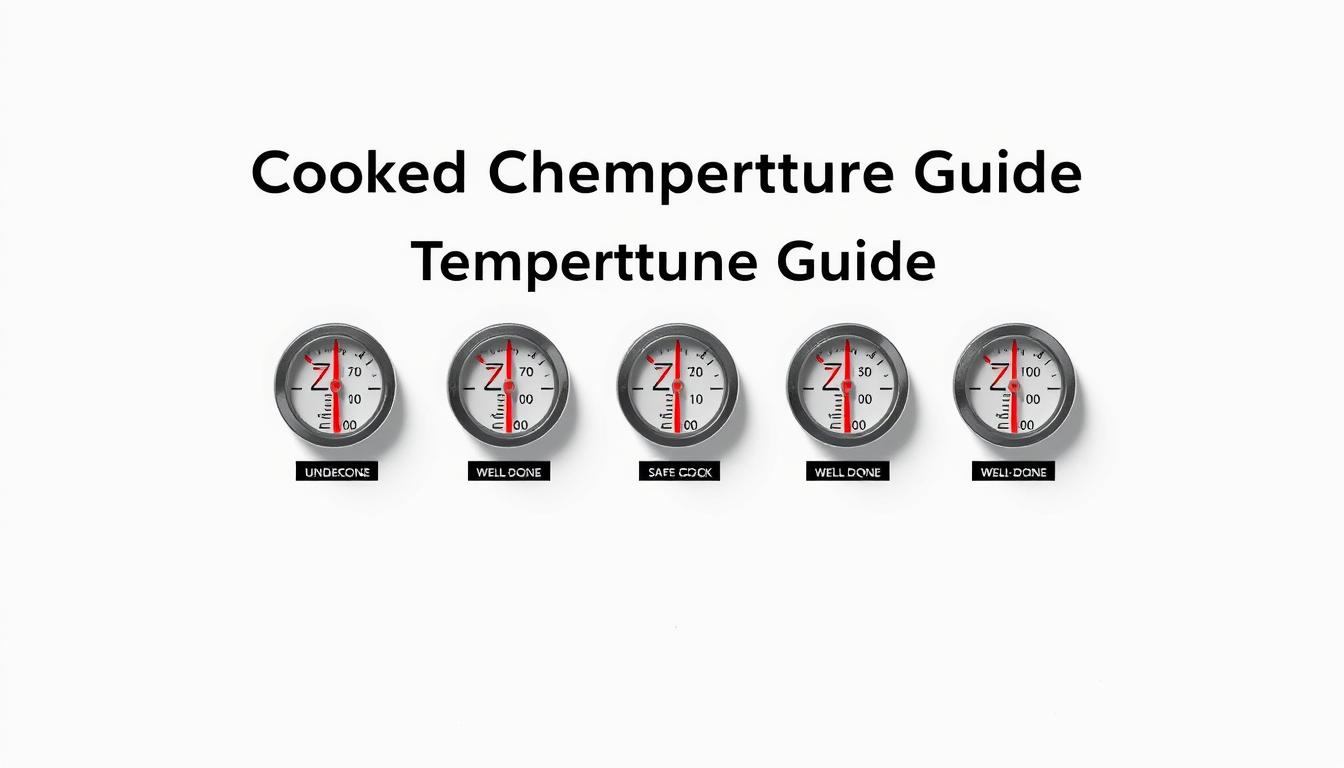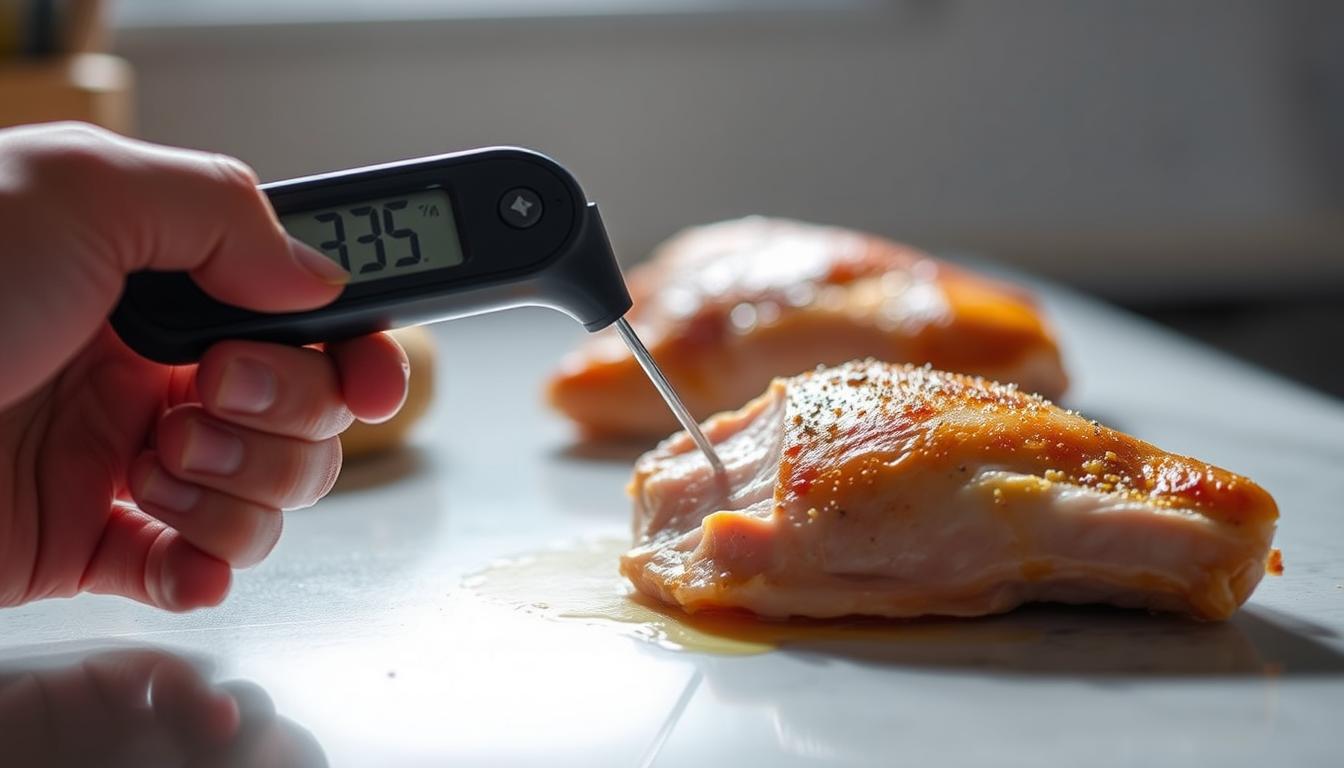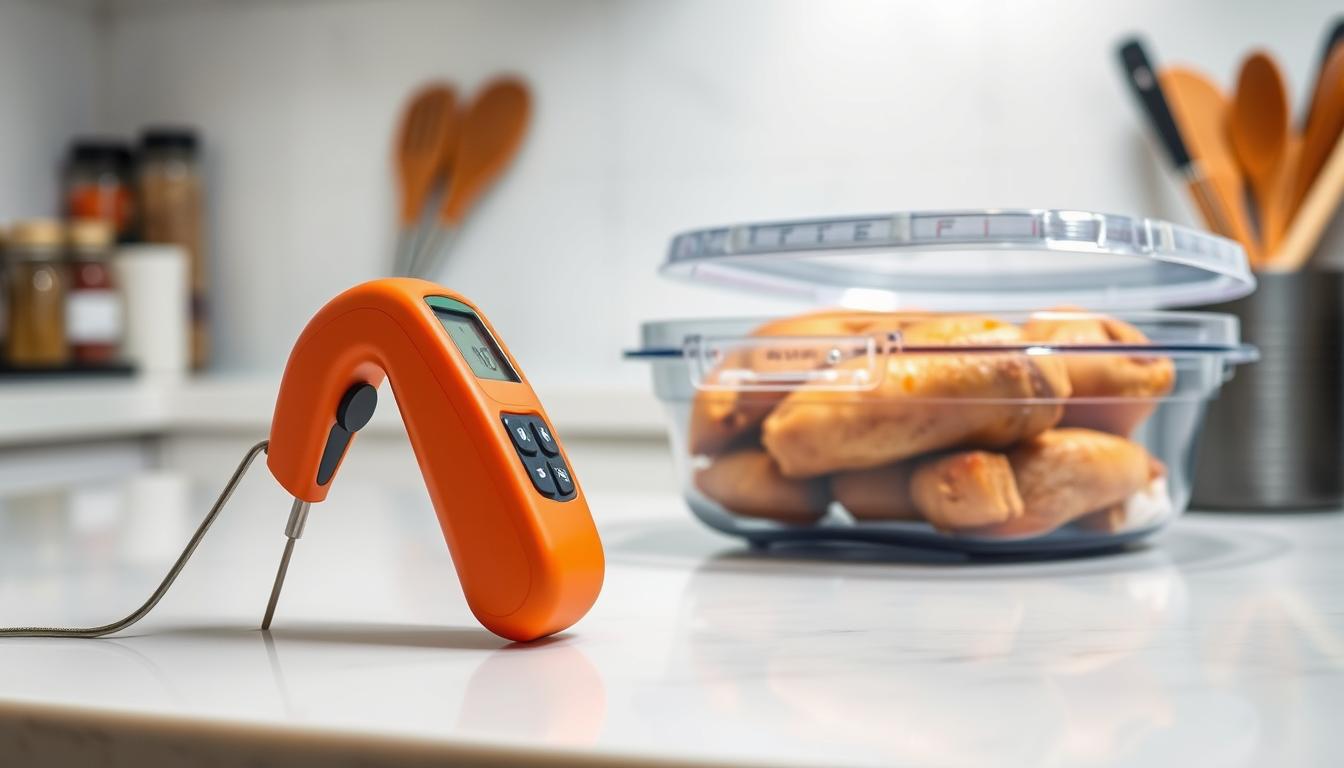
Table of Contents
Cooking chicken perfectly requires more than just culinary skill—it demands precise temperature knowledge. Understanding the right cooked chicken temp is crucial for creating delicious meals while protecting your family from foodborne illnesses.
Food safety begins with knowing exactly when your chicken reaches the optimal temperature. Whether you’re preparing chicken marinade recipes or roasting a whole bird, temperature control is key to preventing potential health risks.
This comprehensive guide will walk you through everything you need to know about achieving safe and delectable chicken dishes. From understanding USDA guidelines to mastering temperature testing techniques, you’ll become a confident home chef in no time.
Key Takeaways
- Proper chicken temperature ensures food safety and delicious meals
- Different chicken cuts require specific temperature ranges
- Invest in a reliable meat thermometer
- Allow chicken to rest after cooking for even temperature distribution
- Understanding the “danger zone” prevents bacterial growth
Understanding Food Safety and Temperature Guidelines
Food safety is a critical aspect of cooking that protects you and your family from potential health risks. Understanding temperature guidelines helps prevent foodborne illnesses and ensures delicious, safe meals for everyone.
Cooking meat to the right cooked chicken temp isn’t just about taste—it’s about safety. Bacteria can multiply rapidly when food is left in the wrong temperature range, making proper cooking techniques essential for both chicken and beef recipes.
USDA Temperature Requirements
The United States Department of Agriculture (USDA) provides clear guidelines for safe cooking temperatures:
- Chicken breast: 165°F (74°C)
- Ground chicken: 165°F (74°C)
- Whole chicken: 165°F (74°C) in the thickest part
Why Proper Temperature Matters
Cooking meat to the correct internal temperature eliminates harmful pathogens. Undercooked chicken can harbor dangerous bacteria like Salmonella and Campylobacter, which can cause serious foodborne illnesses.
Danger Zone Temperatures
Food scientists identify the “danger zone” as temperatures between 40°F and 140°F (4°C to 60°C). In this range, bacteria can double in number every 20 minutes, making rapid cooling or heating crucial for food safety.
- Keep hot foods above 140°F
- Refrigerate cold foods below 40°F
- Minimize time spent in the danger zone
Essential Tools for Measuring Chicken Temperature
Achieving the perfect cooked chicken temp requires more than just culinary skill. The right tools can transform your cooking experience and ensure food safety every time you prepare chicken dishes, including delicious fajitas recipes.
Selecting the right temperature measurement tool is crucial for home cooks and professional chefs alike. Several key instruments can help you monitor chicken temperatures accurately:
- Instant-Read Digital Thermometers: Quick and precise, these handheld devices provide rapid temperature readings in seconds
- Probe Thermometers: Ideal for monitoring temperatures during cooking, with a probe that stays in the meat while the digital display remains outside the oven
- Infrared Thermometers: Non-contact devices that measure surface temperatures without touching the chicken
When preparing fajitas recipe or roasting chicken breasts, an instant-read digital thermometer offers the most versatility. Look for models with:
- Wide temperature range
- Clear digital display
- Quick response time
- Durability and water resistance
Investing in a quality thermometer ensures you’ll always achieve the safe cooked chicken temp recommended by food safety experts. Prices range from $10 to $50, making them an affordable kitchen essential that can prevent foodborne illnesses and guarantee delicious meals.
The Perfect Cooked Chicken Temp for Different Cuts
Achieving the right cooked chicken temp is crucial for both food safety and delicious meals. Different cuts of chicken require specific temperature guidelines to ensure they’re perfectly cooked and safe to eat. Understanding these temperature variations can elevate your cooking skills and prevent potential foodborne illnesses.
Cooking chicken isn’t as straightforward as preparing other meats like a filet mignon recipe. Each chicken cut has unique characteristics that impact its ideal cooking temperature and time.
Breast Meat Temperature Insights
Chicken breast is lean and can easily become dry if overcooked. The recommended internal temperature for chicken breast is 165°F (74°C). At this temperature, you’ll achieve:
- Safe, fully cooked meat
- Juicy and tender texture
- Elimination of harmful bacteria
Dark Meat Temperature Considerations
Dark meat, including thighs and drumsticks, contains more fat and can withstand slightly higher temperatures. While 165°F remains the food safety benchmark, many chefs recommend cooking dark meat to 175°F for optimal tenderness.
| Chicken Cut | Safe Internal Temperature | Recommended Cooking Method |
|---|---|---|
| Chicken Breast | 165°F | Baking, Grilling, Poaching |
| Chicken Thighs | 175°F | Roasting, Braising |
| Ground Chicken | 165°F | Pan-frying, Baking |
Ground Chicken Safety
Ground chicken requires extra attention due to increased surface area for bacterial growth. Always cook ground chicken to a consistent 165°F throughout, using a reliable meat thermometer to verify the temperature.
“Precision is key when cooking chicken. A few degrees can make the difference between a safe, delicious meal and a potential health risk.” – Professional Chef
Pro tip: Always let chicken rest for 3-5 minutes after cooking to allow temperature distribution and juice redistribution.
Common Mistakes When Checking Chicken Temperature

Cooking chicken to the right cooked chicken temp can be tricky. Many home cooks make critical errors that compromise food safety and taste. Recognizing these common mistakes helps ensure your meals are both delicious and safe to eat.
- Using an Incorrect Thermometer Placement
- Inserting the thermometer in the wrong spot can give misleading readings. Always check the thickest part of the meat, avoiding bone, fat, or gristle.
- Removing Chicken Too Early
- Impatience leads to undercooked chicken. Let the meat reach the full recommended internal temperature before removing from heat.
- Not Calibrating Your Thermometer
- An uncalibrated thermometer can be off by several degrees. Regularly check and adjust your cooking thermometer for accuracy.
These principles extend beyond chicken. When preparing a flank steak marinade, similar temperature checking techniques apply. The key is precision and patience.
| Mistake | Potential Consequences | Correct Approach |
|---|---|---|
| Incorrect Thermometer Placement | Inaccurate temperature reading | Insert in thickest part of meat |
| Rushing the Cooking Process | Potential foodborne illness | Ensure full temperature is reached |
| Ignoring Thermometer Calibration | Unreliable temperature measurements | Regularly check and adjust thermometer |
Pro tip: Invest in a reliable digital meat thermometer to eliminate guesswork and ensure food safety every time you cook.
Visual Signs of Properly Cooked Chicken
Checking the cooked chicken temp goes beyond using a meat thermometer. Visual cues can help you determine if your chicken is ready to eat. While temperature remains the most reliable method, understanding these visual indicators can boost your cooking confidence.
Professional chefs know that identifying perfectly cooked chicken involves multiple sensory checks. These techniques work across various cooking methods, from roasting to preparing a beef stir fry recipe.
Color Changes to Look For
Raw chicken typically appears pink or translucent. When fully cooked, chicken transforms:
- White meat turns completely white
- Dark meat shifts to light brown
- No pink areas should remain
Texture Indicators
Texture provides another critical clue about chicken doneness:
- Firm to touch – not soft or rubbery
- Meat should pull apart easily
- Fibers separate without excessive resistance
Juice Clarity Test
When piercing the thickest part of the chicken, observe the juices:
- Clear juices indicate proper cooking
- Pink or red liquid suggests undercooked meat
- Wait until juices run completely clear
Remember, while these visual signs help, always use a meat thermometer to confirm the cooked chicken temp reaches 165°F for guaranteed safety.
Best Practices for Temperature Testing
Mastering the art of checking cooked chicken temp is crucial for both food safety and delicious meals. Professional chefs and home cooks alike know that accurate temperature testing can make or break your chicken dish.
When testing chicken temperature, follow these essential guidelines:
- Use a reliable digital meat thermometer
- Insert the thermometer into the thickest part of the meat
- Avoid touching bones or fat when measuring
- Clean your thermometer between uses to prevent cross-contamination
Different chicken marinade recipes may require slight variations in temperature testing. For instance, marinated chicken might cook slightly differently due to the added moisture and ingredients.
“The key to perfect chicken is precision, not guesswork.” – Culinary Expert
Here’s a quick reference for thermometer placement:
| Chicken Cut | Best Thermometer Placement |
|---|---|
| Whole Chicken | Inner thigh, away from bone |
| Chicken Breast | Thickest part of the meat |
| Chicken Thighs | Center of the thickest section |
Pro tip: Let your thermometer sit for 10-15 seconds to get an accurate reading of the cooked chicken temp.
Resting Time and Temperature Carryover
Cooking chicken isn’t just about reaching the right cooked chicken temp. The resting period plays a crucial role in ensuring your meal is both safe and deliciously juicy. Similar to preparing stew meat recipes, allowing chicken to rest after cooking helps distribute heat and juices evenly.
During the resting phase, chicken continues to cook through a process called carryover cooking. This means the internal temperature can rise another 5-10 degrees Fahrenheit after removing it from heat. Understanding this phenomenon helps home cooks achieve perfectly cooked chicken every time.
Proper Resting Techniques
To maximize flavor and ensure food safety, follow these resting guidelines:
- Remove chicken from heat source
- Transfer to a clean cutting board
- Tent loosely with aluminum foil
- Let rest for 3-10 minutes depending on size
Temperature Changes During Rest
The resting period allows muscle fibers to relax and reabsorb juices. For chicken breasts, aim for a 5-minute rest. Larger cuts like whole chickens might require up to 15 minutes. Professional chefs know that patience during this stage can transform an average dish into a culinary masterpiece.
Pro tip: Always use a meat thermometer to verify the final cooked chicken temp during the resting period.
Storage and Reheating Temperature Guidelines

Proper storage of cooked chicken is critical for maintaining food safety and preserving flavor. After preparing your delicious grilled chicken marinade recipe, knowing the right storage techniques can help prevent foodborne illnesses and keep your meal tasty.
When storing cooked chicken, follow these essential guidelines:
- Refrigerate cooked chicken within 2 hours of cooking
- Store in airtight containers or sealed plastic bags
- Keep refrigerator temperature at or below 40°F
- Consume refrigerated chicken within 3-4 days
Reheating requires careful attention to cooked chicken temp to ensure safety. Always use a meat thermometer to verify the internal temperature reaches 165°F throughout the chicken. Uneven heating can leave dangerous bacteria alive.
Different reheating methods impact chicken quality:
- Oven: Preheat to 350°F, cover with foil to retain moisture
- Microwave: Use medium power and rotate frequently
- Skillet: Add a small amount of broth to prevent drying
For grilled chicken marinade leftovers, slice before refrigerating to help cool quickly and promote even reheating. Remember that multiple reheating cycles can degrade meat quality and increase food safety risks.
Pro tip: When in doubt, throw it out! Food safety always trumps saving leftovers.
Conclusion
Cooking chicken to the perfect cooked chicken temp isn’t just about safety—it’s about creating mouthwatering meals every time. By understanding precise temperature guidelines, home cooks can transform ordinary poultry dishes into restaurant-quality experiences. The techniques you’ve learned extend beyond chicken, potentially improving your skills with beef stew meat recipes and other protein preparations.
Temperature control remains the most critical factor in preparing delicious and safe meals. Whether you’re grilling, roasting, or pan-searing, using a reliable meat thermometer guarantees consistent results. Professionals and home chefs alike recognize that internal temperature is the gold standard for determining when meat is perfectly cooked.
As you continue developing your culinary skills, remember that practice makes perfect. Invest in a quality instant-read thermometer, learn your cooking equipment’s nuances, and always prioritize food safety. Your commitment to understanding cooked chicken temp will elevate your cooking and protect your family’s health with every meal you prepare.
With these insights, you’re now equipped to confidently approach chicken preparation. From understanding danger zones to recognizing proper doneness, you’ve gained essential knowledge that transforms ordinary cooking into a precise culinary art. Embrace these techniques, and watch your kitchen skills soar to new heights.
FAQ
What is the safe internal temperature for chicken breast?
The safe internal temperature for chicken breast is 165°F (74°C). Always use a meat thermometer to check the thickest part of the meat to ensure it has reached this temperature, which kills harmful bacteria and ensures food safety.
How do I know if my chicken is fully cooked without a thermometer?
While a thermometer is the most accurate method, you can check for visual signs like clear juices (not pink), white (not pink) meat throughout, and a firm texture. However, these methods are not as reliable as using a digital meat thermometer.
Do different chicken cuts have different cooking temperatures?
While the safe internal temperature is 165°F for all chicken cuts, dark meat like thighs and legs can handle slightly higher temperatures without becoming dry. Breast meat is more delicate and can dry out quickly if overcooked.
How long should I let chicken rest after cooking?
Let chicken rest for 3-5 minutes after cooking. This allows the juices to redistribute, making the meat more tender and helping it retain moisture. The temperature will continue to rise slightly during this resting period.
Can I eat chicken if it’s slightly pink?
No, chicken should never be pink in the middle. Color is not a reliable indicator of doneness. Always use a meat thermometer to ensure the internal temperature has reached 165°F (74°C) to kill potential harmful bacteria.
What’s the danger zone for chicken temperature?
The danger zone for chicken is between 40°F and 140°F (4°C to 60°C). Bacteria multiply rapidly in this temperature range, so it’s crucial to cook chicken quickly and store it at proper temperatures to prevent foodborne illnesses.
How do I properly store cooked chicken?
Refrigerate cooked chicken within two hours of cooking (or within one hour if the temperature is above 90°F). Store in airtight containers and consume within 3-4 days. When reheating, ensure the internal temperature reaches 165°F again.
What type of thermometer is best for checking chicken temperature?
An instant-read digital thermometer is the most accurate and convenient tool. Look for a quick-response model with a sharp probe that can easily be inserted into the thickest part of the chicken without touching bone or fat.
